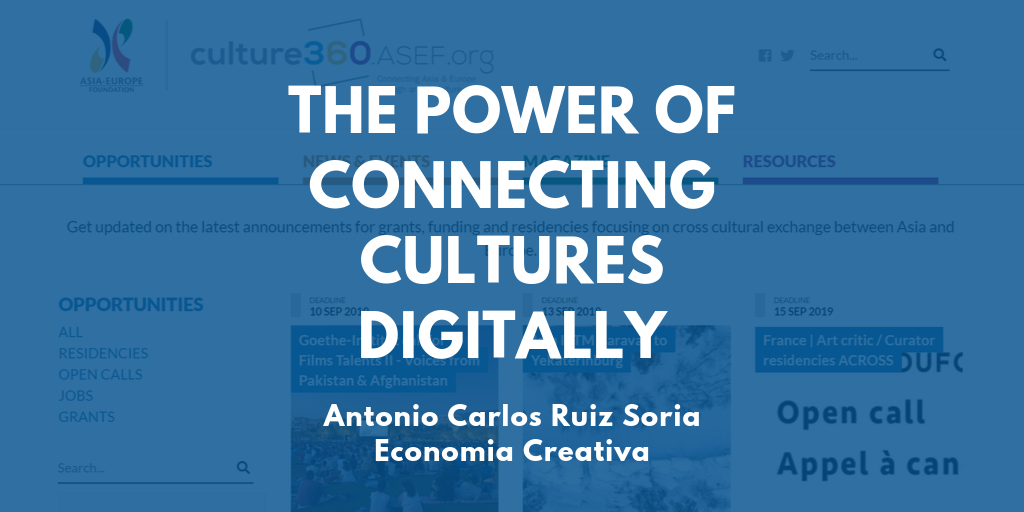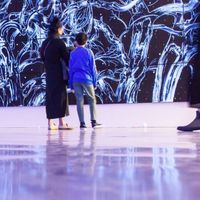The power of connecting cultures digitally

Culture is an ever more important factor for international relations due to globalization and the advancement of the network society, enabled by communication technologies, which have reconfigured the power dynamic between different social actors (Governments and international institutions, multi-national corporations (MNC), civil society organisations and citizens).
The role of culture and CCS in public diplomacy
On one hand, many countries have focused their public diplomacy on culture, developing cultural diplomacy agendas using culture as soft power, the key to the hearts and minds of the foreign public.
On the other hand, culture and the creative sectors (CCS) is the economic pillar of cultural diplomacy. Nowadays countries compete to increase their market share in the creative economy global market by promoting their arts and culture, cultural heritage, architecture and design, music and performing arts, gaming, audio-visual and cinema, among other creative sub-sectors, in order to attract foreign audiences to their nation’s creations and differentiate themselves from others. CCS is at the core of national branding strategies in an constantly more competitive global outlook.
ASEAN and European Union, leading the global creative goods trade
According to UNCTAD (UNCTAD, 2018, Creative Economy Outlook, Trends in international trade in creative industries), “the size of the global market for creative goods has expanded substantially more than doubling in size from 208 billion USD in 2002 to 509 billion USD in 2015. While the financial crisis affected the creation, production and distribution of creative goods, its trade performance has generally been consistent, with an average growth rate exceeding 7 per cent between 2002 and 2015”. Developing economies’ participation in creative goods trade was markedly higher than in developed economies, driven mainly by the performance of China”. The top 10 performing developing economies on creative goods exports over the period 2002 to 2015, following China, were Hong Kong (China), India, Singapore, Taiwan, Turkey, Thailand, Malaysia, Mexico and the Philippines. The UNCTAD also highlights that “the domination of Asian countries in the top ten is a clear indication of their important emerging role in stimulating and contributing to the global creative economy”.
Within developed economies, the top ten creative goods exporters were led by the United States, followed by France, Italy, United Kingdom, Germany, Switzerland, Netherlands, Poland, Belgium and Japan. The European Union (28) is the largest exporter of creative goods in developed economies. Together the Association of South East Asia Nations (ASEAN) and the European Union dominate the export of creative goods.
CCS’ contribution to the 2030 UN Agenda
CCS is also contributing to concrete Sustainable Development Goals (SDGs) of the 2030 UN Agenda, reinforcing its strength as a strategic arena for impact investment, sustainable and inclusive development to tacking global challenges (from inequality and gender balance, to environment, migration and refugees, among others), while empowering people and transforming lives at local level. In particular, the report by Culture 2030 Goal campaign (2019), “Culture in the Implementation of the 2030 Agenda”, shows evidences of cultural policies and programmes addressing concrete Goals such as SDG11 (sustainable cities and communities, on cultural heritage and on the use of public spaces); SDG4 (quality education), SDG5 (gender equality), SDG8 (decent work and economic growth), SDG9 (infrastructures), SDG10 (reduced inequalities), SDG12 (sustainable production and consumption), SDG15 (life on land) and SDG16 (peace, justice and strong institutions).
Digital cultural platforms as catalyst for international cooperation and exchange
In this context, digital platforms play a unique role by connecting cultures and audiences, linking different actors, enhancing intercultural dialogue, cooperation and exchange for a more dynamic ecosystem. Digital cultural platforms organize content within the myriad of online sources, developing networks of meaning and facilitating a communicative environment that creates the perfect ground for multi-lateral and multi-stakeholders partnerships.
An excellent example of digital platform connecting cultures, regions, creative sectors, audiences, and effectively linking the two global regions leading the global creative good exports, Asia and Europe, is culture360.ASEF.org –where this article is published.
Launched in 2008, culture360.ASEF.org has been recurrently acknowledged by different institutions as an existing tool for the exchange of information on diversity of cultural expressions (UNESCO); and as an “excellent model of information exchange for Asia-Europe cultural co-operation” (European Commission); it contributes to SDG4, SDG16 and SDG17 (partnership for the Goals).
Multi-national corporations (MNC) engagement with arts and culture
MNC have also understood the importance of arts and culture on their business development and internationalization strategies. They acknowledge that to enter new markets they cannot focus only on figures and market intelligence; they also have to gain trust and credibility and show commitment to local communities and their culture through their corporate citizenship and social corporate responsibility programmes. Engagement with local culture and arts is understood by MNC as a vehicle to reinforce their brands, improving their reputation, gaining credibility and trust, and accessing niche and highly influential audience (artists and creatives). This is the reason why many MNC (from across sectors, from technology, financial and insurance, to energy, automobile, FMCG or health care and beauty) have CSR and sponsorship programmes specifically dedicated to promoting art and culture and, more broadly, the CCS.
In many cases, such as UBS bank, MNC have abandoned the traditional sponsorship schemes understood as a simple financial transaction; instead they are willing to establish win-win partnerships with artists, art organizations or intermediaries (such as digital platforms or NGOs), enabling co-creation, exchanging knowledge and co-marketing the projects they often commission or co-curate. The Guggenheim UBS MAP Global Art Initiative provides an unparalleled example of this type of partnership between cultural institution and corporation (from financial sector).
MNCs, particularly from technology sector, focus their cooperation with art and culture on exploring the vectors art-digital-AI (Artificial Intelligence) and how to connect culture and communities, making art accessible to everyone, including those who otherwise would not be reached. Such is the case of Yamaha Group project Asian Beat, one of the biggest amateur band contests held throughout many regions in Asia.
Corporate sponsors of creative organizations or artists are usually primarily looking for marketing, business development and PR benefits from these partnerships, therefore communication and (digital) storytelling are necessary to enable successful partnerships.
The power of connecting cultures digitally
Thus, in the midst of the 21st century creative society, in which the wealth of the nations is measured by their creativity and the knowledge they create, for public and private actors and civil society organisations, the (soft) power resides on connecting cultures (digitally). This positions digital cultural platforms as essential partners and catalyst for international cooperation and exchange.
Antonio Carlos Ruiz Soria is a leading international expert and speaker on creative & digital economy, sustainability and entrepreneurship; founder of Economía Creativa, creativity and innovation lab. He is a creative thinker and ecosystem maker providing strategic advice, actionable development plans, feasibility studies, research, speaking and capacity building (in more than 16 countries) for international organizations, governments, NGOs, start up hubs/accelerators, corporations, and creative enterprises with a co-creation methodology and cross-sectoral approach. His recent assignments include a Feasibility Study carried out for the Asia-Europe Foundation (ASEF) for public and private sector funding for its Culture 360 digital platform, (from which this article is based). www.economiacreativa.eu
For more information about ASEF culture360, click here: https://culture360.asef.org/about-us/
Similar content
posted on
26 Jul 2019
posted on
17 Dec 2019
deadline
15 Jun 2022
17 Oct 2018
from - to
28 Oct 2019 - 28 Oct 2019
deadline
16 Jun 2021






